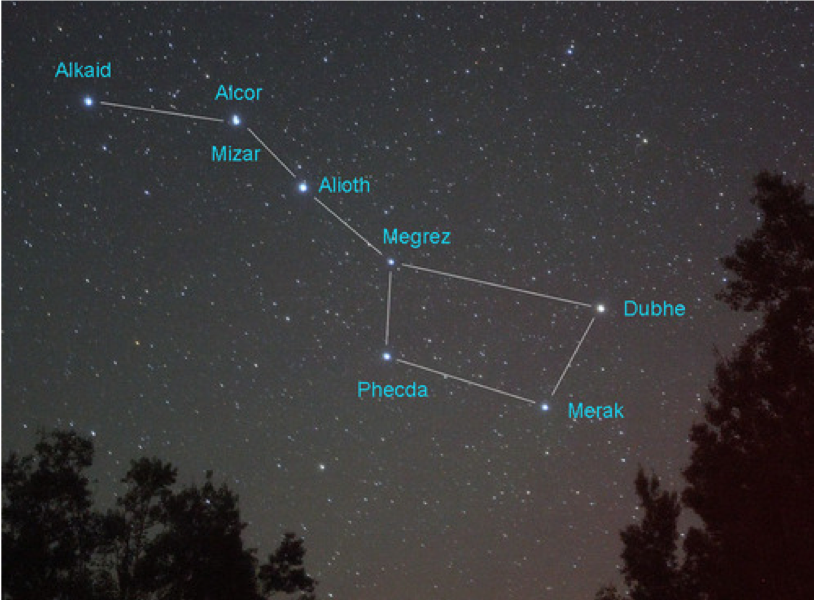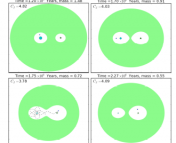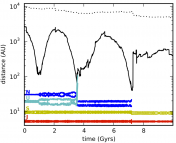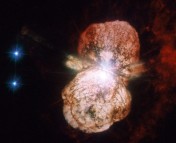Title: The Turbulent Origin of Outflow and Spin Misalignment in Multiple Star Systems
Authors: Stella Offner, Michael Dunham, Katerine Lee, Hector Arce, and Drummond Fielding
First Author Institution: Department of Astronomy, University of Massachusetts
Status: Open access on ArXiv, closed access on ApJ

If you live at a similar latitude to me, or live in the northern hemisphere (hopefully with less cloudy snowy weather… #Michigan), you can see the big dipper on the horizon right now. It is visible right after sunset. You might be familiar with the seven bright stars that make up this asterism. But hold up! It’s actually eight stars. In the middle of the handle, there are actually two stars very close to each other called Mizar and Alcor. Normally when you look at any two bright stars next to each other in the sky, they are not physically close to each other. One could be very bright and far away, the other dimmer and closer to us. But Mizar and Alcor are actually gravitationally bound to each other, orbiting a common center of mass. This is what we call a binary star system (although Mizar and Alcor actually have some extra fainter companions, making it a multiple star system).
Turns out that there are many stars out there that are in what we call binary, or multiple star systems. We also see a wide range of separations between the stars in these systems. For example, two stars could be anywhere from just 30 AU out to 10,000 AU apart from each other. Binary star systems occur very frequently. We even see exoplanets around them. The way binary systems evolve can have tremendous insight into high energy phenomena such as x-ray binary systems, stellar evolution, and the population of field stars. This is all to say that binary systems exist, and it is very much worth understanding how they got to be there!
Looking at little baby stars, we see that even at these young ages, stars form alongside other stars forming a binary or multi-star system right from the beginning. There are two main paths to forming two stars at once. One, is turbulent fragmentation. That happens when you have a molecular core infalling and starting to form a star, but something happens like a shock wave or other source of turbulence that produces an over-density within that core, forming a sort of secondary core within a core. The second method is disk fragmentation. That happens when a protostellar disk has started to form, but perhaps it is growing in mass very quickly, and a gravitational instability can be triggered, forming a ‘seed’ of a secondary companion. In general, one might assume that turbulent fragmentation would lead to binary systems with wide separations, and disk fragmentation would lead to shorter separations. This is because turbulent fragmentation can happen over very large distances, but disk fragmentation only occurs in a disk with typically is around 200AU. You might also expect that turbulent fragmentation will lead to stars with different and random spins while stars forms from ~the same disk would have aligned spins. This paper explores the question: If turbulent fragmentation is occurring, what would the final state of binary/multi-star systems look like?
In order to explore this problem, this group creates simulations that start with a molecular core of uniform density and uniform magnetic field. They then produce some turbulence with random motions and random intensities and see what happens. They run this simulation on molecular cores of 4, 6, and 8 solar masses so that there is enough mass for turbulence to have an effect over a wide range, and not so massive where they accidentally form a massive star.
They run a total of 12 simulations with different core masses and random turbulent fields, and they end up forming five single stars, five binary systems, and two triple systems. So turbulent fragmentation works! Great, now, they want to see how far apart these stars are from each other typically. They plot the average separation over time and produce this figure:

From these simulations, they find that binary systems will start out at far separations, with the lower mass cores producing stars ~600 AU apart while the more massive cores produce stars ~3000 AU apart. But, over a very short period of time (just a measly 100,000 years) all binary systems will start to migrate inwards, with the separation between stars becoming much smaller, even down to a few 10s of AU. So, turbulent fragmentation does not necessarily mean that you will end up with stars very far apart from each other. All stars that form via turbulent fragmentation seem to migrate inward, so if we see a short separation binary star system out there, that doesn’t really tell us about how it might have formed.
But what about star spins? If the stars form disassociated from each other, then their spins should be totally random. This simulation also tracks how spins of the different stars change over time, and they find that, at the very beginning, all the spins start out totally random. But as they progress, they saw that the stars would interact with each other, influencing the other’s spin. The lower mass cores seemed to have spins that leaned towards correlating while on the higher mass end, the stars were less correlated. Overall, comparing the spin differences along side what is observed, they see that their simulation agrees well with what is observed. This suggests that the observed sample could have been driven by turbulent fragmentation formation!
They also converted their computer simulations into simulated observations, matching the density of the gas to CO emission. Astronomers use CO as a tracer of star forming regions because it is quite abundant and is a good probe of temperature in these temperature regimes (~10K – 100ish K). Using CO emission, they can also simulate jets that come out from the star that is aligned with the angular momentum of the star. This allows them to directly compare their simulations to observations, and they find that their simulated CO emission maps match what is observed very well!

This paper was able to simulate the formation of binary and multiple star systems using the process of turbulent fragmentation. They found that as a binary system formed in this process evolves, the stars start to migrate inward, losing any sort of information about the initial separation. They do find however, that the stars spin are not aligned. They are either random or anti-aligned, a determination of which would necessitate more simulations with higher resolution. Comparing to observations of wide-separation binaries, the simulations tend to agree with what we know, suggesting that those stars formed via turbulent fragmentation.




